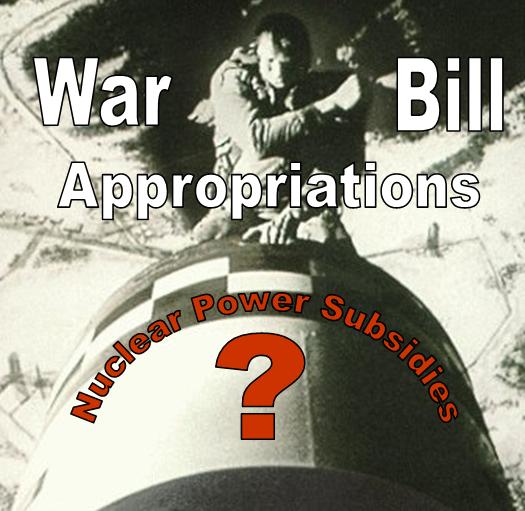Ramming Nuclear Power Subsidies Into War Appropriations Bill Is Inappropriate and Should Be Blocked
A Deal is Struck to Add $9 Billion in Risky Nuclear Loan Guarantees for Failing South Texas Nuclear Project.
In a deal between the Obama administration and House of Representatives leadership, struck last week behind closed doors, taxpayers would be on the hook for lending $9 billion to build two new nuclear reactors at the South Texas Project site in Bay City, Texas.
 It is highly inappropriate for the Obama administration to stuff subsidies for nuclear power into an emergency war appropriations bill and lawmakers should strip this nuclear utility pork out of the war funding bill. Subsidizing new reactors that will take a decade or more to build cannot be considered an emergency and it is a stretch of the imagination to see how exactly it is related to the wars in Afghanistan and Iraq.
It is highly inappropriate for the Obama administration to stuff subsidies for nuclear power into an emergency war appropriations bill and lawmakers should strip this nuclear utility pork out of the war funding bill. Subsidizing new reactors that will take a decade or more to build cannot be considered an emergency and it is a stretch of the imagination to see how exactly it is related to the wars in Afghanistan and Iraq.
Public Citizen and the Sustainable Energy and Economic Development (SEED) Coalition are challenging the South Texas nuclear reactors’ license before the Atomic Safety and Licensing Board, and Karen Hadden of the SEED Coalition said, “It is clear that the only emergency here is the fact that the South Texas plant doesn’t have sufficient investors to make this a viable project.” 
After the estimated cost of the project more than tripled in three years to a whopping $18.2 billion, the city of San Antonio wisely pulled out of 85 percent of its investment. Tokyo Electric Power Company (TEPCO) has since offered a measly 10 percent investment. NRG, the primary stakeholder in the Texas project, has been financially shaky in recent years and filed for bankruptcy in 2003, making it incomprehensible how the U.S. government can justify backing this lemon of a project with $9 billion of taxpayer money.The nuclear loan guarantees not only commit taxpayers to underwrite risky nuclear reactor projects but also allow wealthy nuclear utilities to borrow the money from the government’s Federal Financing Bank. Funds for this bank come directly from the U.S Treasury. When federal loans are defaulted on, U.S. taxpayers pay are on the hook to pay back the loan. These guarantees are a pre-emptive nuclear industry bailout.
The $9 billion in loan guarantee authority for new reactors is in addition to the $18.5 billion that the U.S. Department of Energy (DOE) has yet to give out. The DOE has offered $8.33 billion in guarantees to Southern Company for two reactors in Georgia, but Southern Company recently asked for a month extension to decide if it would accept them.
The remaining $10 billion is widely expected to be offered to Unistar, a consortium of Constellation Energy and the French-government owned utility Electricity de France, for a reactor in Maryland. From the outset, Unistar has been unable to accurately estimate project costs. The reactor design, which remains uncertified by U.S. regulators, is currently under construction in Finland and France. Both projects have been plagued with delays and cost overruns. The Finnish project is three and a half years behind schedule with a 75 percent cost overrun thus far. Moreover, the consortium is currently facing legal challenges to its right to build and operate a reactor under the Atomic Energy Act, which prohibits foreign control of U.S. nuclear reactors. A consideration that has yet to be addressed around the Japanese utility company, TESCO’s investment into the South Texas Project.
The Maryland project is riddled with its own financial uncertainties. The cost estimates for the proposed new reactor at Calvert Cliffs Nuclear Power Plant, located on the Chesapeake Bay, climbed from $5 billion in 2007 to $10 billion in 2009. Even that high figure is likely to be low, since a Pennsylvania utility has posted an estimate of $13-15 billion for precisely the same reactor design at Bell Bend in Pennsylvania.
The DOE’s criteria for awarding loan guarantees backed by taxpayer money to applicants is not transparent, and the criteria for choosing the contenders that have risen to the top of the bailout list is anyone’s guess. This runs completely counter to the ‘most transparent administration ever’ promised by President Barack Obama.
Safer, more affordable energy solutions are available. For example, energy efficiency is proving to be less expensive than the city of San Antonio anticipated. Their forecast of the amount of electricity needed by 2020 has dropped by approximately 20 percent. If we were doing a real risk assessment on how to invest taxpayer money, we’d invest in affordable energy efficiency, safe renewable power such as solar, wind and geothermal, and energy storage to maximize the clean energy produced.